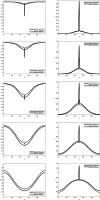Network Structured Kinetic Models of Social Interactions
- PMID: 34026904
- PMCID: PMC8128985
- DOI: 10.1007/s10013-021-00505-8
Network Structured Kinetic Models of Social Interactions
Abstract
The aim of this paper is to study the derivation of appropriate meso- and macroscopic models for interactions as appearing in social processes. There are two main characteristics the models take into account, namely a network structure of interactions, which we treat by an appropriate mesoscopic description, and a different role of interacting agents. The latter differs from interactions treated in classical statistical mechanics in the sense that the agents do not have symmetric roles, but there is rather an active and a passive agent. We will demonstrate how a certain form of kinetic equations can be obtained to describe such interactions at a mesoscopic level and moreover obtain macroscopic models from monokinetics solutions of those. The derivation naturally leads to systems of nonlocal reaction-diffusion equations (or in a suitable limit local versions thereof), which can explain spatial phase separation phenomena found to emerge from the microscopic interactions. We will highlight the approach in three examples, namely the evolution and coarsening of dialects in human language, the construction of social norms, and the spread of an epidemic.
Keywords: Kinetic models; Network structured interactions; Nonlinear nonlocal equations; Reaction-diffusion equations; Social networks.
© The Author(s) 2021.
Figures
Similar articles
-
Continuum mesoscopic framework for multiple interacting species and processes on multiple site types and/or crystallographic planes.J Chem Phys. 2007 Jul 21;127(3):034705. doi: 10.1063/1.2748755. J Chem Phys. 2007. PMID: 17655453
-
Macroscopic description of particle systems with nonlocal density-dependent diffusivity.Phys Rev E Stat Nonlin Soft Matter Phys. 2006 Jul;74(1 Pt 1):012102. doi: 10.1103/PhysRevE.74.012102. Epub 2006 Jul 20. Phys Rev E Stat Nonlin Soft Matter Phys. 2006. PMID: 16907141
-
Systematic derivation of reaction-diffusion equations with distributed delays and relations to fractional reaction-diffusion equations and hyperbolic transport equations: application to the theory of Neolithic transition.Phys Rev E Stat Nonlin Soft Matter Phys. 2002 Dec;66(6 Pt 1):061908. doi: 10.1103/PhysRevE.66.061908. Epub 2002 Dec 19. Phys Rev E Stat Nonlin Soft Matter Phys. 2002. PMID: 12513319
-
Correlation between hierarchical structure of crystal networks and macroscopic performance of mesoscopic soft materials and engineering principles.Chem Soc Rev. 2015 Nov 7;44(21):7881-915. doi: 10.1039/c5cs00074b. Chem Soc Rev. 2015. PMID: 26214062 Review.
-
Nonlocal Reaction-Diffusion Equations in Biomedical Applications.Acta Biotheor. 2022 Mar 17;70(2):12. doi: 10.1007/s10441-022-09436-4. Acta Biotheor. 2022. PMID: 35298702 Review.
Cited by
-
Mean-Field Selective Optimal Control via Transient Leadership.Appl Math Optim. 2022;85(2):9. doi: 10.1007/s00245-022-09837-4. Epub 2022 Apr 13. Appl Math Optim. 2022. PMID: 35535172 Free PMC article.
References
-
- Allen SM, Cahn JW. Ground state structures in ordered binary alloys with second neighbor interactions. Acta Metall. 1972;20:423–433. doi: 10.1016/0001-6160(72)90037-5. - DOI
-
- Amann H. Dynamic theory of quasilinear parabolic equations II. Reaction-diffusion systems. Differ. Integral Equ. 1990;3:13–75.
-
- Axelrod, R.: The Complexity of Cooperation: Agent-Based Models of Competition and Collaboration. Princeton University Press, Princeton (1997)
LinkOut - more resources
Full Text Sources
Other Literature Sources

